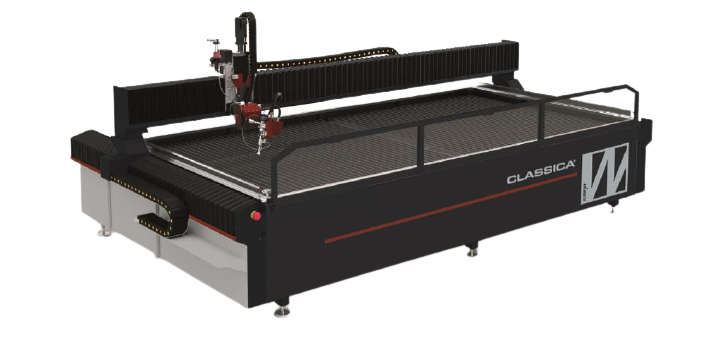Catchysigns’s vision is to be the premier custom sign company in DC Area, being unmatched in capability, service, and value.
In keeping with our vision, Catchysigns has purchased a top-of-the-line 5-axis waterjet cutting machine with Hydro finish to better meet your needs. If you are looking for a manufacturer to fabricate high-quality, Products consider choosing Catchysigns.

Waterjet Cutting & Hydrofinsh
WHAT IS A WATERJET ?
A waterjet is a cutting tool that uses ultra-high pressure water combined with an abrasive such as garnet to cut almost any type of material. Waterjets can cut very intricate and precise parts, and 5-axis waterjets can cut beveled and tapered edges.
The waterjet cutting process offers manufacturers flexibility that no other cutting process can offer. A waterjet cutting has a range of applications and can cut irregular shapes from almost any material with exceptional precision and edge quality. Curves, straight cuts, internal holes and lettering once cut by hand can now be cut in a fraction of the time by waterjet.

Advantages of Waterjet Cutting
No Heat Affected Zones
Waterjet is a cold cutting process which eliminates problems caused by heat distortion and hardened edges. This is particularly advantageous for intricate metal fabrication and products which require additional machining after cutting
Can Cut Almost Any Material
Compared with other cutting techniques, waterjets can handle just about any material or product that a traditional cutters can. In addition, materials like plastics, rubber, laminated materials, stone, glass, or materials with uneven surfaces can all be handled through waterjet cutting.
Offers the Ability to Cut Complex Shapes
Waterjet cutting is especially advantageous for projects requiring the ability to cut complex shapes. Materials can be cut into any shape. Sharp corners, bevels, pierce holes, and shapes with minimal inner radius are all possible. Stacking, nesting and tabbing optimize material and can significantly reduce cutting times.
Waterjets are Environmentally Friendly
Waterjets produce no hazardous waste. This inevitably helps to reduce waste disposal costs. Highly skilled operators can cut off large pieces of reusable scrap metal that may have been lost using traditional cutting methods. Beyond that, water jet cutting allows for parts to be closely nested to maximize material use, saving material by minimizing kerf. Waterjets also use less water than you may assume, as water that is used can be recycled using a closed-looped system. Waste water is typically clean enough to filter and dispose of down a drain
The list of how water jet cutting can help you get what you need is endless.
- Aluminum
- Titanium
- Brass
- Stainless steel
- Hardened steel
- Tool steel
- Glass
- Bulletproof glass
- Mirror
- Stone
- Concrete
- Ceramics
- Tile Marble
- Copper
- Granite
- Corian
- Rubber
- Foam
- Brake lining
- Laminates
- Composites
- Carbon fiber
- Fiberglass
- Plastic
- Acrylics
- Cork
- Gaskets
- Seals
- Teflon
- Leather
- Wood
Decorative Hydrofinish

Hydrofinish is the innovative technology used to process the surfaces of different materials with a high-pressure waterjet (up to 2000 Bar). Unlike the cutting, in this application the jet of water has a lower pressure, but a broader range. An high-pressure pump forces a jet of water through a multi-nozzle rotating body controlled by a PLC. The ejected water then allows you to finish the processed surface by means of accelerated erosion. This technology, called Hydrofinish,
In general, this technology is intended for decorative purposes: the capacity to preserve the original color of the processed material, the option to select the level of coarseness suitable for the desired application and the applicability of this technology on any thickness make it an essential work tool. The degree of erosion produces various finishing effects on the surface and together with the chromatic variety of each material preserved during the process, this results in decorative effects that cannot be reproduced with other technologies.
The various levels of coarseness are obtained by modifying three primary factors: the pressure employed during the process, the distance between the nozzle and the material, and the synchronized speed at which the nozzle moves.
As in the cutting process, the Hydrofinish system is an entirely environmentally sustainable industrial process, since it does not produce smoke, heat or polluting liquid waste.
